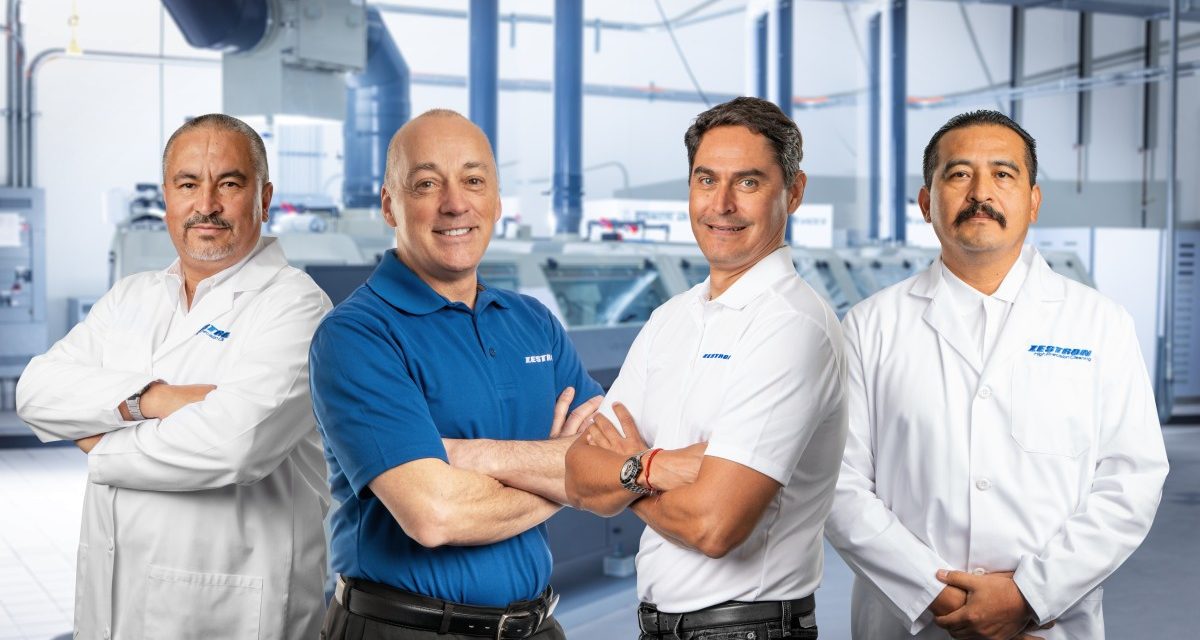EMSNOW Executive Interview: Sal Sparacino, Zestron Mexico – Part One

Zestron has been operating in Mexico for decades. The Mexico team has a number of initiatives to enable customers to ‘Design for Sustainability’. That country was one of the first to pass specific laws about climate change. We caught up with Sal Sparacino who heads up the team in Mexico to learn more about Zestron’s extensive work in this arena in that critical Americas manufacturing hub.
EMSNOW: Tell us a little about the history of ZESTRON in Mexico.

Sal Sparacino
ZESTRON has been highly active in Mexico since the 1990s. Located within Mexico, we have a Regional Sales Manager with responsibility for Latin America, as well as two Application Engineers. This is in addition to a distribution network supporting the market including warehouses for product inventory and additional sales and technical support personnel.
EMSNOW: Are sustainability initiatives taking root in Mexico?
As reported by SGI 2022 (Sustainable Governance Indicators), Mexico was one of the first countries in the world to pass a specific law on climate change. So there is and has been governmental focus on sustainability. It is notable that electronics manufacturing in Mexico is projected to reach $12.41bn in 2023 (reported by Statista). Additionally, Statista reports that revenue is expected to show an annual growth rate (CAGR 2023-2027) of 11.86%, resulting in a projected market volume of US$19.43bn by 2027.
This is exemplified by the numerous Tier 1 electronic CMs (contract manufacturers) that are located in Mexico and continue to grow both organically and through onshoring. Many, if not all of these companies have ESG (Environmental, Social, and Governance) initiatives. A key part of this is ‘Design for Sustainability’. As defined by the US General Services Administration, sustainable design seeks to reduce negative impacts on the environment, and the health and comfort of building occupants, thereby improving building performance. The basic objectives of sustainability are to reduce consumption of non-renewable resources, minimize waste, and create healthy, productive environments. So yes, sustainability initiatives are taking root in Mexico.
EMSNOW: How are ZESTRON products supporting the sustainability initiative?
Reducing negative impact on the environment is a key component of Design for Sustainability. To this point, reducing the release of VOCs (Volatile Organic Compounds) into the atmosphere is a worldwide concern. VOCs contribute to air pollution and can have detrimental effects on human health. Certain hydrofluorocarbons (HFCs), which can be considered VOCs due to their organic nature and volatility, are greenhouse gases that can contribute to climate change. Thus, reducing VOC emissions has been and continues to be a priority for many countries.
VOC is a complex topic for a uniform global standard has not been created and accepted. What is defined as a VOC, VOC limits, methods for VOC calculation, and acceptance of VOC-exempt compounds, vary by geographic location.
Within the US, the most stringent limitation on VOC emissions is in Southern California. Here, the district is monitored by SCAQMD (South Coast Air Quality Management District) which mandates a limit of 25 grams/liter (as per Rule 1122) in the working solution of the chemicals used with inline and batch cleaners (referred to as “cold cleaners”). Exemptions to the rule are given, however only for specialized applications such as the manufacture of medical devices or components used in space. Even then, permits are required to use higher VOC cleaning agents which can be expensive and require regular renewal.
Zestron’s core business is the formulation and distribution of water based cleaning agents for the electronics manufacturing industry. The primary use of these products is defluxing electronic assemblies as well maintenance cleaning the various tools used throughout the SMT process. Often times our products are replacing solvent products such as IPA which are nearly 100% VOC. Zestron water based products have significantly lower VOCs at use concentration thereby supporting sustainability initiatives.
Most recently, Zestron has developed water based defluxing agent with the lowest VOC level, as defined by SCAQMD, of any product in the market; that is, less than 20 g/l at use concentration. For companies that have ISO 14000 initiatives, reducing VOC emissions is a goal for which Zestron’s low VOC products can certainly impact.
EMSNOW: How do Zestron products support worker safety?
Worker safety is a key concern for any manufacturer. As electronics assembly requires using chemicals, or as Zestron produces, water based cleaning agents as part of the process, ensuring that our products are as safe as possible is a primary objective. To this point, many Zestron products are GreenScreen™ certified. GreenScreen™ Certified for Cleaners & Degreasers applies to all industrial applications, especially within the electronics sector. Knowing which products are safer for workers can be a complicated task for manufacturers which is why GreenScreen™ Certified for Cleaners & Degreasers was created. It provides assurance that these products are third party certified, free of PFAS and thousands of chemicals of high concern and protective of worker
HMIS (Hazardous Materials Identification System) is a hazard rating system used in the United States to convey health, flammability, and physical hazard information about chemicals and products that are used in manufacturing. The scale is ‘0’ to ‘4’ with ‘0’ being the least hazardous and ‘4’ being very hazardous. A ‘0’ rating indicates minimal hazard which means that the material poses no significant risk to health. Thus, all Zestron cleaning agents have an HMIS rating.
I would like to note that ZESTRON pioneered pH Neutral aqueous based cleaning agents in 2010. These products are environmentally friendly and have very low VOCs at use concentration. For example, The HMIS rating of one of the Zestron pH Neutral cleaning agents at working concentration is 0-0-0 (Health-Flammability-Reactivity).
EMSNOW: Can you share any partnerships or collaborations your company has engaged in to promote sustainability within the electronics manufacturing industry?
ZESTRON R&D personnel were Key Contributors with the development of the Standard for Cleaners & Degreasers in Manufacturing. This standard provides the means for manufacturers to communicate their use of safer chemicals per the GreenScreen® hazard assessment tools.
Additionally, IPC, a Global Association for Electronics Manufacturing, is drafting IPC-1402, a Standard for Green Cleaners Used in Electronics Manufacturing. Zestron R&D Scientist, Dr. Terry Price, is the Vice Chair for the committee. The goal of this committee is to develop a standard for the electronics manufacturing industry that defines and sets minimum criteria for green cleaners; that is chemical cleaners meeting a defensible set of green chemistry requirements used in electronics manufacturing processes.
Zestron is very committed to working with industry professionals in defining standards for meeting global sustainability objectives.
This discussion continues tomorrow in Part Two of this in-depth and thoughtful interview. Sal Sparacino discusses the issue of waste, which products are being replaced, research and development efforts and much more.












